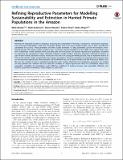Refining reproductive parameters for modelling sustainability and extinction in hunted primate populations in the Amazon
Abstract
Primates are frequently hunted in Amazonia. Assessing the sustainability of hunting is essential to conservation planning. The most-used sustainability model, the 'Production Model', and more recent spatial models, rely on basic reproductive parameters for accuracy. These parameters are often crudely estimated. To date, parameters used for the Amazon's most-hunted primate, the woolly monkey (Lagothrix spp.), come from captive populations in the 1960s, when captive births were rare. Furthermore, woolly monkeys have since been split into five species. We provide reproductive parameters calculated by examining the reproductive organs of female Poeppig's woolly monkeys (Lagothrix poeppigii), collected by hunters as part of their normal subsistence activity. Production was 0.48-0.54 young per female per year, and an interbirth interval of 22.3 to 25.2 months, similar to parameters from captive populations. However, breeding was seasonal, which imposes limits on the maximum reproductive rate attainable. We recommend the use of spatial models over the Production Model, since they are less sensitive to error in estimated reproductive rates. Further refinements to reproductive parameters are needed for most primate taxa. Methods like ours verify the suitability of captive reproductive rates for sustainability analysis and population modelling for populations under differing conditions of hunting pressure and seasonality. Without such research, population modelling is based largely on guesswork.
Citation
Bowler , M , Anderson , M , Montes , D , Pérez , P & Mayor , P 2014 , ' Refining reproductive parameters for modelling sustainability and extinction in hunted primate populations in the Amazon ' , PLoS One , vol. 9 , no. 4 , e93625 . https://doi.org/10.1371/journal.pone.0093625
Publication
PLoS One
Status
Peer reviewed
ISSN
1932-6203Type
Journal article
Description
Funding: Collections were made voluntarily by local people as part of a community conservation project. Some materials were paid for by YAVACUS, a Peruvian NGO.Collections
Items in the St Andrews Research Repository are protected by copyright, with all rights reserved, unless otherwise indicated.

